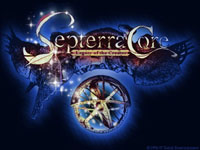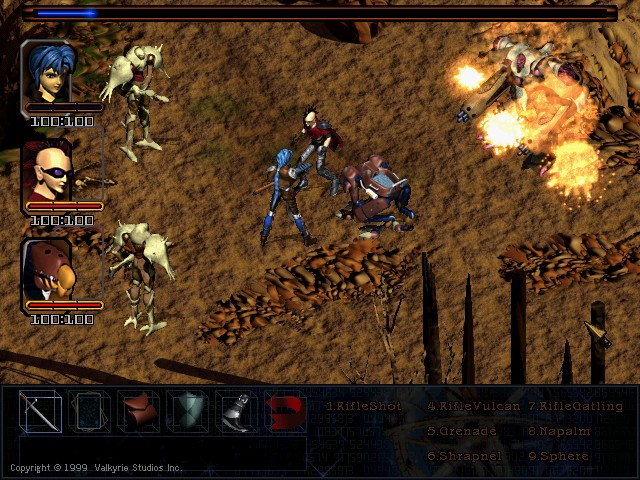|
|

|
BATTLE SYSTEM
|

|
INTERACTION
|

|
ORIGINALITY
|

|
STORY
|

|
MUSIC & SOUND
|

|
VISUALS
|

|
CHALLENGE
|
Moderate
|
COMPLETION TIME
|
50+/- Hours
|
|
OVERALL
3.5/5
|
Rating definitions
|
|
|
RPGs had raised a new bar in gaming in the late nineties. Immensive gameplay, with complex storylines paired with FMV have become expectations for new games in this genre. Septerra Core, a game that somewhat flew under the radar after its release in 1999, uses most of these elements. Looking at the game at first glance, you may not be certain what to expect, except that you are entering a world with seven different world shells all connected to one spine which surrounds the core of the planet. However, the gamer will be immersed into the experience right away with plenty of backstory.
For the most part, Septerra Core is very story-driven. The first few hours of the game will be spent collecting information about the world, and its history. From that point on, the gaming experience is massive amounts of fighting, big dungeons, and loads and loads of bugs. Despite its problems (no game is perfect, mind you), Septerra Core is still a solid gaming experience.
The battle system is really interesting. When you enter a battle, each character has a time bar. One third of the way full, the character can use a basic, weak attack, as well as weaker abilities. Two thirds of the way, the character can use a stronger attack, and ultimately, a full bar allows a fierce attack. This type of customizability allows the gamer to determine how strong he or she wants an attack to be. Not to mention it's great not to have to fill up the bar the entire way to use an item. Another neat aspect is that there are no random encounters, a norm in current RPGs.
The magic system is also somewhat innovative. In order to cast spells, you need to use a variety of "Fate Cards". Usage of these cards requires energy from your party's "Core". Since everybody shares the Core amongst the three of them, usage of these cards is limited. At first, since the cards require a lot of Core energy, not to mention offer little assistance, they are mostly useless. However, the later you get into the game, the more useful the cards become. If a monster is attacking you constantly, casting a cloak on your party raises your evasion drastically. If a boss can wipe out your party in one attack, casting a defensive barrier is life-saving.
 Bitch, you just got SERVED!
Bitch, you just got SERVED!
|
|
Unfortunately, despite a solid system, it does have its drawbacks. For example, there is a lot of fighting, and I do mean a lot. There is also a significant amount of time from one attack to the next. Since some of the dungeons can be rather long, the lengthy battles only make them seem longer, forcing you to be in some areas for literally hours at a time.
The neat thing about this game, since it's a PC RPG, is that everything can be done using the mouse. By clicking on certain NPCs or environments all around, it allows the player to really interact with every part of every area. This allows particular items to be discovered in obscure places, as well as unlocking new levels to explore.
A big setback regarding interactivity is the movement of your characters. If you want to turn around and leave a room, you won't be able to move because one of your other party members is standing in the way. You actually have to walk around in a big circle, allowing your entire party to follow you, before leaving a room. Also, if a character can't reach a certain object, it gets into a loop. The character will take a strange route to get to something nearby, as not a lot of programming went into optional routes. One time, when I went to activate a switch, the character couldn't get around either an obstacle or a standstill party member and was walking back and forth with no way to cancel the action. I had to actually exit the game and restart (fortunately you can save anytime just in case something occurs, but it is an inconvenience).
An alternative to the "epic" scores you will find in most RPGs, Septerra Core takes a different route. Most of the areas that you enter contain little to no music. Busy towns will hum with activity from electronic devices and conversation from locals, forests will contain chriping of birds and rustling of leaves, sewers will give off the scattering sound of running rats and the dripping of water. Most of the music you will hear will take place during either battles, or the world map (and each shell contains a different theme).
Unfortunately, the existing music could have been more polished. There are four or five different battle themes, with only one or two that really stand out while the others just seem to be "there". Also, there is no boss music. Not even for the final boss. How is there no music for a final boss? Fortunately, the high quality of voice acting more than makes up for this (every piece of written dialogue in the game is spoken).
 Usurping the government happens in every RPG.
Usurping the government happens in every RPG.
|
|
What I like about Septerra Core is its originality. The characters, the world and the battle systems are a breath of fresh air. You learn about different "castes" of people. Since some are direct descendants of the hero who saved the world in the past, they believe to be "above" everybody else of the world. The creatures living on the lowest world shell get the least amount of light. Since they do not have eyes, they have adapted a personal sound radar which allows them to find their way, almost working as well as eyes.
The characters stand out from any other RPG I've played. Compared to other protagonists who always want to do the "right thing" while avoiding fighting even the bad guys who are threatening to kill you, Maya is a protagonist that I really like. She always knows what to do and never hesitates when a difficult decision must be made. She's even threatened many enemies to hand over items that she knows will be properly misused in their hands. It's a shame there are not more RPGs with characters such as this.
As you play through Septerra Core, you'll notice that the storyline doesn't change much at all. Your objective from the beginning of the game is the same from when you fight the final boss. Eventually, most of the plot becomes "fetch and retrive" quests. The quests wouldn't be as bad if the dungeons weren't so big. The dungeons tend to contain the exact same idea: an area is divided into several sub-levels, you then must travel to every sub-division to find a key to enter the NEXT sub-division. You then find the key you need, and proceed to find the item you were sent there to get, with an optional boss battle.
An aspect that bothers me is the way objectives are presented (or lack thereof). The game's engine almost forces the gamer to figure out almost everything on his or her own. I know I've had to look through walkthroughs over a dozen times, only to wonder how anyone at all could figure it out with such little information.
For a game released in 1999, the game still looks good with this review being written nearly 7 years after its initial release. The pre-rendered backgrounds are colourful and vibrant. The battle animations, particularly when casting spells, look very nice. Another neat, yet subtle thing, is how much effort was put into the lighting of the game. When the characters enter a dark area, they will be instantly shaded. If it is dimly lit, a small shadow will appear behind the character, and change its size and position accordingly while passing through the light.
Although the game does not contain any polygons, any common gamer can pop in this game and enjoy the visuals. While they are not state of the art, they still look pretty good. The FMV looks pretty polished, too.
One thing that is pretty consistent is the level of challenge throughout the game. You will always need a specific item from "some place" (thank you for helping us, NPCs!) to advance from one area to another.
As for the difficulty of battling, sometimes the monsters can become too easy once equipment is upgraded, and other times the monsters will completely kick your party's ass from one battle to the next. Fortunately, enough cash is gained to both upgrade your equpiment and purchase multitudes upon multitudes of recovery items. If anything, Valkyrie Studios made accessing recovery items too easy. For example, eventually you can purchase really, REALLY good recovery items at a reasonable price (fully restore HP and Core?! I'm buying 20 of these!). Levelling up is never really all that necessary; if a boss is absolutely your party, mostly a change of strategy is needed.
If you check out other reviews for this game, they will say that you'll have to plug away 75+ hours into completing the game. Wait, what? No, this game is not nearly that long. Considering there are not that many sidequests, a first-time player will finish this game in just under 50 hours. It's a length that is mostly due to long dungeons and long battles. It's a somewhat exhausting experience and doesn't really encourage a second play-through right away.
For the most part, Septerra Core is a really solid title. It features a good story, a great battle system, damn good visuals, not to mention terrific voice acting and characters all-around. Unfortunately, the game is hampered with objectivity issues, not to mention bugs within the game engine. So, if you're into trying something different, and if you enjoy long dungeons, give this title a shot.
Review Archives
|









